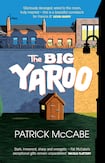
The Big Yaroo is Patrick McCabe’s sequel to The Butcher Boy. The latter novel, published in 1992, is a classic of Irish literature. In a tradition reaching from Synge to Martin McDonagh, it expresses a state of deprivation by representing lethal violence through the prism of comedy.
As a prose narrative it achieves feats of brilliance that go beyond the necessary simplicity of dramatic form. Francie Brady mocks the platitudes of his surroundings through perverse imitation. He turbo-charges his comic-book influences into endless fuel for heroic fantasy. Like another iconic literary killer, Patrick Bateman in American Psycho, he makes culture seem at once ludicrously empty and deadly serious.
Most extraordinarily of all, The Butcher Boy achieves an effect that sometimes eludes tragic tales of unfortunate childhood. Even before the tears of an unnamed emotion stream down Francie’s face at the end, it’s clear that his story is the consequence of rejection following on rejection, of lack of love spawning a creature who can’t be loved.
Spaced out and enfeebled by medication, isolation, cancer, he remains dangerously responsive to insult
The Big Yaroo meets up with Francie 50 years later, still incarcerated in an asylum. Francie has discovered a new purpose, as the publisher, writer, editor, deputy editor, assistant editor, advertising executive and so on (a page-long joke) of his own magazine, The Big Yaroo of the title. This name refers to a boy’s-own-adventure yelp of pain appropriately attributed to Francie by the priest attached to the institution, who draws a cartoon of him with the noun in a speech bubble.
Surreal genius
The narrative is composed of mostly happy or anodyne reminiscences of Francie’s father and mother, guilt-ridden dreams about his crimes, whimsical flights of invention, and exchanges with oddball inmates and staff. These strands interweave, which is The Big Yaroo’s version of the layering aesthetic of The Butcher Boy, where Francie’s scathing, surreal genius daubed even the most horrifying scenarios in hilarity.
While younger Francie was full of exuberant indignation (“I never seen the like of that bogman. He had this big tuft of hair sticking up and two other indicators on either side”), older Francie lists through disjointed observation and caveat, his favourite conjunction being an ampersand. Spaced out and enfeebled by medication, isolation, cancer, he remains dangerously responsive to insult – especially his erstwhile trigger, PIG – and to prospects of finding his vanished holy grail, maternal affection.
Like The Butcher Boy, The Big Yaroo has a contemporary-historical frame. Francie attempted to escape the asylum on September 11th, 2001, and now, “the greatest gonk of them all”, Donald Trump, is president. The horizons of the 1960s persist in Francie’s ignorance of foreigners and his cold war-era fears. He takes the gang who attack him during his breakout for Russians, and he pities Trump if he really is the pawn of an ex-KGB operator.
Some of the best writing in the novel evokes an aloneness that gapes through the waves of distraction
In both novels there is a sense of history as an omnipresence never directly encountered. Each features a character claiming a connection to Michael Collins, a figure fantastic both for the decisiveness and the brevity of his real existence. The Big Yaroo reminds us again of the fountain in Francie’s hometown built for a Queen Victoria who never showed up.
Palliative cliche
But what is the driving force of the sequel? Younger Francie desecrated a genteelly absurd Ireland devoted to JFK and John XXIII. It appears that self-publishing Francie, consumer of television and the internet, mimic of palliative cliche, might share a general condition with his readers, whom he addresses as if they were also stuck in the loony bin. Some of the best writing in the novel evokes an aloneness that gapes through the waves of distraction.
Obsessed with human-replacing technology, Francie points out – in a fragment where he returns from the future to visit his victims in the guise of a character called “googleboy” – that the one thing such toys can’t do is reverse the destructiveness of the past. At the same time, he registers the futility (“I suppose there you are”) of interpreting the digital glut.
More stubborn is the impression that Francie’s occupation refers self-reflexively to his own reanimation as a literary phenomenon. The deadline for issuing his magazine looms toward the end, and its haphazard material is partly coextensive with that of the novel itself.
The predominance of whimsy over comedy throughout, as well as the fact that Francie’s once-startling polemics often seem to have become degraded into mere abusiveness, suggest that The Big Yaroo embodies not the revival of an original literary creation but the burden such a creation might impose.
Introducing another random ditty, Francie explains that his method is to chew on a pen and come up with “anything at all”. Still unprincipled, he’s certainly being ominous here, in a new, very different way.
Catherine Toal is Dean of Bard College Berlin













